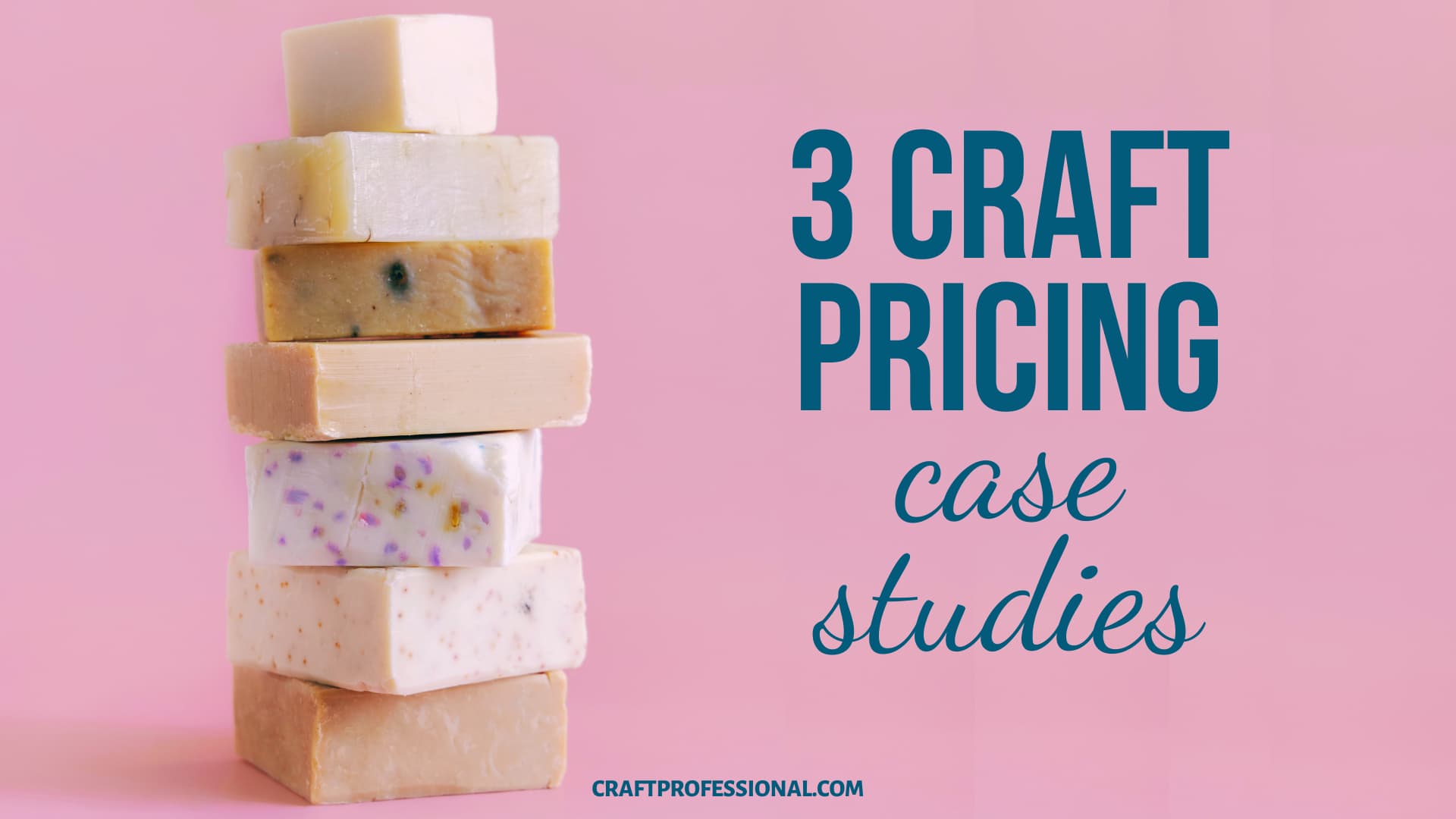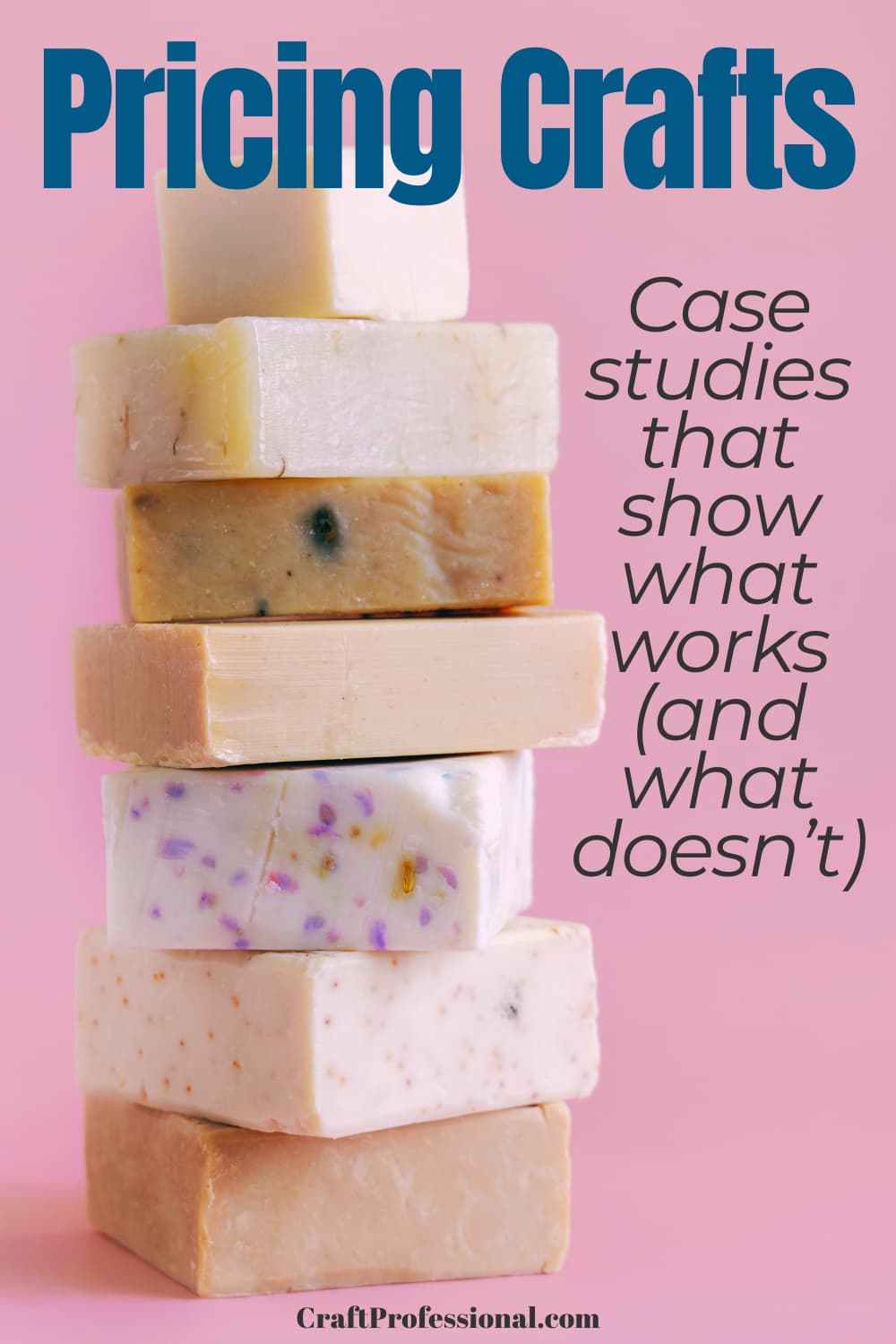- Home
- Craft Pricing
- Case Studies
Pricing Crafts: Case Studies That Reveal What Really Works (and What Doesn't)
Pricing crafts is one of the trickiest challenges in building a profitable handmade business. Everyone tells you to charge what you're worth, but that advice doesn't help much when you're staring at your spreadsheet and wondering if your prices will deter customers.
So let's fix that!
On this page, you won't find vague theories. You'll discover practical case studies. We'll walk through the craft pricing formulas, tools, and strategies used.
Whether you're selling at craft fairs, online on Etsy, or through local boutiques, these examples will give you the confidence to price your handmade products to make a real profit.

Case Studies Table of Contents
What you'll find on this page:
3 Craft Pricing Case Studies
Case Study #1: The Underpricer Who Burned Out
Meet "Laura," a jewelry artist who started her Etsy shop selling beaded bracelets for $22 each. Her material costs were around $4, and each bracelet took 45 minutes to make.
She used the following formula:
(Cost of Materials + (Hourly Wage x Time)) x 2 = Retail Price
This formula gave her a suggested price of around $38–40 per bracelet. But... she didn't feel confident asking that much.
So she priced each bracelet at $22.
What happened?
Laura sold a lot at first, but she quickly became overwhelmed. She was making less than $7/hour after fees and packaging. She worked very hard but saw limited reward, no room for growth, and no way out of the cycle.
After 6 months, she shut down the shop.
Lesson Learned: If your price leaves you burned out or broke, it's not sustainable. You need to set prices that account for your time and make you feel good about the work.
Quick Tip: Track Time for Everything
Many crafters forget to include the hidden hours: prepping, cleaning, emailing, marketing. These hidden tasks can double your actual time investment.
Track your time for one week. That will give you a feel for the real amount of labor you put into your business.
Case Study #2: The Maker Who Adjusted Prices at Craft Shows
"Maya" sells hand-knit scarves and mittens at winter craft fairs. At first, she used a simplified version of a standard formula and priced her scarves at $55.
But sales were slow.
At the second craft fair, she dropped the price to $48, and added a cute "Buy 2, Save $5" sign. She made sure the new lower price still covered all of her costs and included room for profit.
What happened?
Sales tripled. She also found that people would bundle mittens and scarves more often, increasing average cart size.
Lesson Learned: Testing is key. Small tweaks to your price and presentation can make a big difference, especially at in-person events. If you're careful with the strategies you use, you can offer discounts without cheapening your brand.
Case Study #3: The Seller Who Went Premium
"James" makes hand-tooled leather wallets. When he first launched, he used mid-range prices (~$60–70 per wallet). But his craftsmanship was outstanding, and he received lots of comments like, "I would pay more for this wallet."
After three months, he repositioned his brand. He raised his prices to $120, adjusted the presentation of his products to maximize perceived value, and began offering a limited quantity of wallets each month.
What happened?
Sales dipped slightly at first… then they picked up with fewer refunds, better reviews, and more loyal customers.
Lesson Learned: Your prices can build your brand. If your product is premium, your price should reflect that. People judge quality by price, make sure yours sends the right message.
The book, How to Price Crafts and Things You Make to Sell, is an excellent resource if you'd like to learn more about boosting perceived value so you can charge more for your handmade items.
What These Case Studies Teach Us
Real handmade sellers face real challenges when deciding what to charge for their items. But every case study here shows that your strategy is something you can test, refine, and improve.
Here's what works:
- Start with a formula to make sure you're covering costs.
- Don't underprice just because you're afraid to charge more.
- Test different prices at different venues (craft shows vs. Etsy vs. consignment).
- Communicate value clearly in photos, descriptions, and branding.
- Believe in your work. Your time and skill are worth charging for.
2 Popular Craft Pricing Formulas (and How They Work)
Let's break down two common formulas used by handmade sellers, with pros, cons, and when to use them.
1. Wholesale to Retail Craft Pricing Formula
(Cost of Materials + Labor) x 2 = Wholesale Price
Wholesale Price x 2 = Retail Price
- Pros: Covers time, materials, and profit; leaves room for scaling the business.
- Cons: Can feel "too expensive" if your audience isn't used to paying for handmade.
2. Basic Markup Formula
(Materials + Labor) × 2 = Retail Price
- Pros: Easier math, feels more approachable to new crafters
- Cons: Often undervalues time and labor, which can lead to burnout.
Which craft pricing formula is right for you? Learn more about 6 popular ways to price your crafts, and take a quiz to find the right strategy for your business.
Free Craft Pricing Worksheets (Download)
Want to run your own numbers like the sellers in these case studies?
Download the free craft pricing formula worksheet.
You'll get:
- A guide to using 6 different, popular craft pricing formulas
- Worksheets for each formula to test different pricing strategies
If you prefer to work online, check out my online craft pricing calculators. You'll find 6 formulas on one page, so you can quickly plug in your numbers and see how each pricing strategy works for you.
Frequently Asked Questions About Pricing Crafts
What's the best formula for pricing handmade products?
What's the best formula for pricing handmade products?
There's no one-size-fits-all formula. The best formula for your business will depend on the nature of your crafts and your business goals. Try several craft pricing formulas to see which one fits your goals and audience.
How do I know if I'm underpricing my crafts?
How do I know if I'm underpricing my crafts?
A good indicator is if you're working hard but not making a profit, or worse, burning out. If your pricing doesn't cover materials, time, and overhead (like packaging and marketing), you're underpricing.
Use one of the tested formulas shared in the link above to check if your current prices are sustainable.
Can I raise my prices without losing customers?
Can I raise my prices without losing customers?
Yes, if you increase perceived value along with the price. Improve product presentation, branding, and customer experience. As seen in James' case study, higher prices can attract better customers when aligned with quality and brand positioning.
Should I offer discounts at craft shows?
Should I offer discounts at craft shows?
You can, but do it strategically. Bundle deals or small promotions (like Buy 2, Save $5) work well when they still maintain your profit margins. Be cautious not to discount too deeply or too often, as it can harm your brands' perceived value.
How can I test my prices without hurting my brand?
How can I test my prices without hurting my brand?
Start by adjusting prices slightly at in-person events or on specific platforms. Track the results.
Pair new prices with stronger value messaging, like better photos or customer reviews, so it feels like an upgrade, not a discount.



New! Comments
Have your say about what you just read! Leave me a comment in the box below.